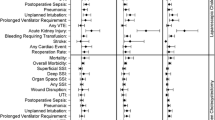Abstract
Purpose
Model of End-Stage Liver Disease (MELD) score was developed to predict mortality in patients with liver disease. The aim of this study was to investigate the relationship between preoperative MELD score and 30-day surgical outcomes using the American College of Surgeons National Surgical Quality Improvement Program.
Methods
Patients with ulcerative colitis (UC) (ICD: 556.X) who underwent colectomy were identified from NSQIP 2005 to 2013. The primary outcomes were bleeding complications, and overall morbidity and mortality.
Results
A total of 7534 UC patients undergoing colectomy were identified. Patients with a higher MELD score had a longer hospital stay; more bleeding; and cardiac, respiratory, renal, thromboembolic, and septic complications as well as mortality. Patients were stratified into 4 groups by MELD score: < 7, 7–11, 12–15, and > 15 and a stratified multivariate analysis was done. Patients with a MELD score 12–15 (odds ratio [OR] 1.9, 95% confidence interval [CI] 1.1–1.3) and MELD > 15 (OR 2.6, 95%CI 1.5–4.7) were at significant risk for bleeding complication. Apart from the MELD score, the presence of ascites (OR 2.5, 95%CI 1.2–5.1) or varices (OR 1.0, 95%CI 1.01–1.03) was also significantly associated with post-operative bleeding complication. MELD 12–15 and MELD > 15 were also found to be risk factors for overall morbidity (OR 5.3, 95%CI 1.8–15.7; OR 10.3, 95%CI 3.6–29.7, respectively) and mortality (OR 3.3, 95%CI 1.3–8.4; OR 5.9, 95%CI 2.4–14.6, respectively).
Conclusion
UC patients with a higher MELD score were associated with a higher post-colectomy morbidity and mortality. MELD score > 11 was an independent indicator for post-operative bleeding, and overall complications and mortality.
Similar content being viewed by others
References
Navaneethan U, Shen B (2010) Hepatopancreatobiliary manifestations and complications associated with inflammatory bowel disease. Inflamm Bowel Dis 16:1598–1619
Gizard E, Ford AC, Bronowicki JP, Peyrin-Biroulet L (2014) Systematic review: the epidemiology of the hepatobiliary manifestations in patients with inflammatory bowel disease. Aliment Pharmacol Ther 40:3–15
Eade MN (1970) Liver disease in ulcerative colitis. I. Analysis of operative liver biopsy in 138 consecutive patients having colectomy. Ann Intern Med 72:475–487
Gisbert JP, Luna M, González-Lama Y, Pousa ID, Velasco M, Moreno-Otero R, Maté J (2007) Liver injury in inflammatory bowel disease: long-term follow-up study of 786 patients. Inflamm Bowel Dis 13:1106–1114
Meunier K, Mucci S, Quentin V, Azoulay R, Arnaud JP, Hamy A (2008) Colorectal surgery in cirrhotic patients: assessment of operative morbidity and mortality. Dis Colon Rectum 51:1225–1231
Neeff H, Mariaskin D, Spangenberg HC, Hopt UT, Makowiec F (2011) Perioperative mortality after non-hepatic general surgery in patients with liver cirrhosis: an analysis of 138 operations in the 2000s using child and MELD scores. J Gastrointest Surg 15:1–11
Zielsdorf SM, Kubasiak JC, Janssen I, Myers JA, Luu MB (2015) A NSQIP analysis of MELD and perioperative outcomes in general surgery. Am Surg 81:755–759
Lange EO, Jensen CC, Melton GB, Madoff RD, Kwaan MR (2015) Relationship between model for end-stage liver disease score and 30 day outcomes for patients undergoing elective colorectal resection. Dis Colon Rectum 58:494–501
Hedrick TL, Swenson BR, Friel CM (2013) Model for end-stage liver disease in predicting postoperative mortality of patients undergoing colorectal surgery. Am Surg 79:347–352
Lian L, Menon KV, Shen B et al (2012) Inflammatory bowel disease complicated by primary sclerosing cholangitis and cirrhosis: is restorative proctocolectomy safe? Dis Colon Rectum 55:79–84
Malinchoc M, Kamath PS, Gordon FD, Peine CJ, Rank J, ter Borg PCJ (2000) A model to predict poor survival in patients undergoing transjugular intrahepatic portosystemic shunts. Hepatology 31:864–871
Halabi WJ, Jafari MD, Nguyen VQ, Carmichael JC, Mills S, Pigazzi A, Stamos MJ (2013) Blood transfusions in colorectal cancer surgery: incidence, outcomes, and predictive factors: an American College of Surgeons National Surgical Quality Improvement Program analysis. Am J Surg 206:1024–1032
Mathis KL, Benavente-Chenhalls LA, Dozois EJ, Wolff BG, Larson DW (2011) Short- and long-term surgical outcomes in patients undergoing proctocolectomy with ileal pouch-anal anastomosis in the setting of primary sclerosing cholangitis. Dis Colon Rectum 54:787–792
Kartheuser AH, Dozois RR, LaRusso NF et al (1996) Comparison of surgical treatment of ulcerative colitis associated with primary sclerosing cholangitis: ileal pouch-anal anastomosis versus Brooke ileostomy. Mayo Clin Proc 71:748–756
Mathis KL, Dozois EJ, Larson DW, Cima RR, Sarmiento JM, Wolff BG, Heimbach JK, Pemberton JH (2008) Ileal pouch–anal anastomosis and liver transplantation for ulcerative colitis complicated by primary sclerosing cholangitis. Br J Surg 95:882–886
Gorgun E, Remzi FH, Manilich E, Preen M, Shen B, Fazio VW (2005) Surgical outcome in patients with primary sclerosing cholangitis undergoing ileal pouch-anal anastomosis: a case-control study. Surgery 138:631–637
Cullen S, Chapman R (2003) Primary sclerosing cholangitis. Autoimmun Rev 2:305–312
Gustot T, Durand F, Lebrec D, Vincent JL, Moreau R (2009) Severe sepsis in cirrhosis. Hepatology 50:2022–2033
Poritz LS, Koltun WA (2003) Surgical management of ulcerative colitis in the presence of primary sclerosing cholangitis. Dis Colon Rectum 46:173–178
Funding
This study was financially supported by the National Key Clinical Discipline (China).
Dr. Bo Shen is supported by the Ed and Joey Story Endowed Chair.
Author information
Authors and Affiliations
Corresponding author
Ethics declarations
Disclosure
The American College of Surgeons National Surgical Quality Improvement Program (ACS NSQIP) and the hospitals participating in the program are the source of the data used herein; they have not verified and are not responsible for the statistical validity of the data analysis or the conclusions derived by the study.
Rights and permissions
About this article
Cite this article
Lan, N., Shen, B. & Wang, J. Predication of post-operative outcome of colectomy in ulcerative colitis patients using Model of End-Stage Liver Disease Score. Int J Colorectal Dis 33, 1763–1772 (2018). https://doi.org/10.1007/s00384-018-3147-y
Accepted:
Published:
Issue Date:
DOI: https://doi.org/10.1007/s00384-018-3147-y




